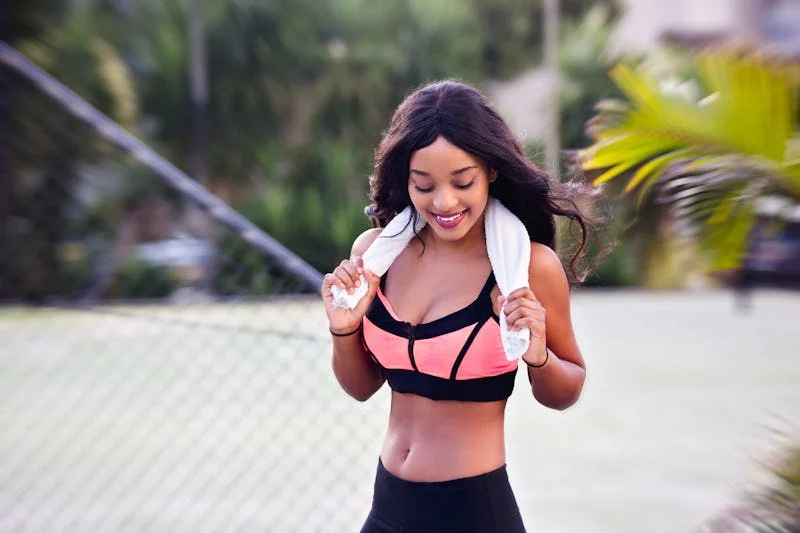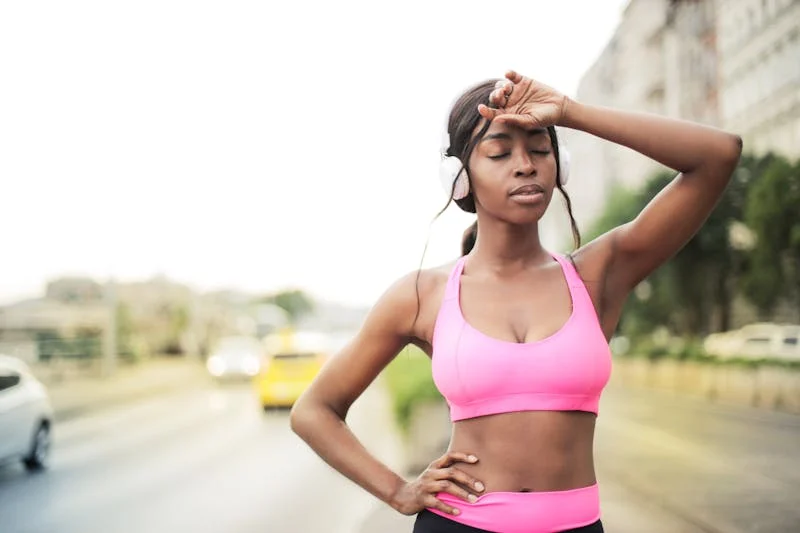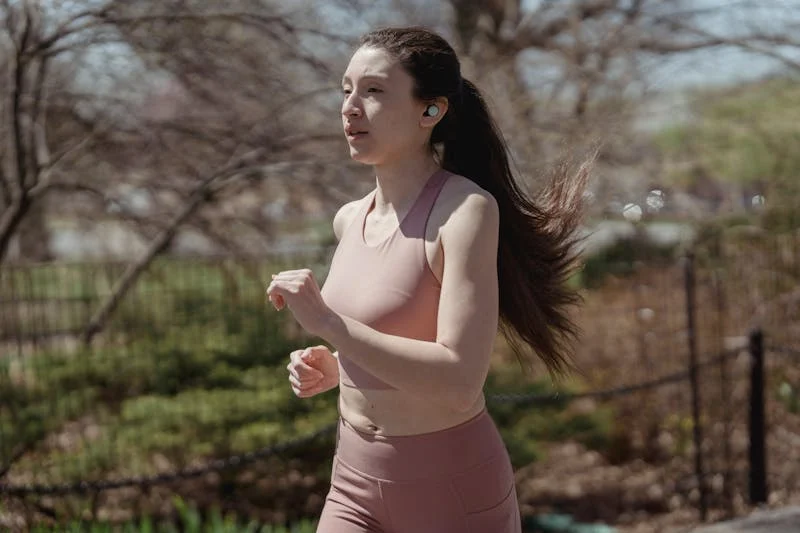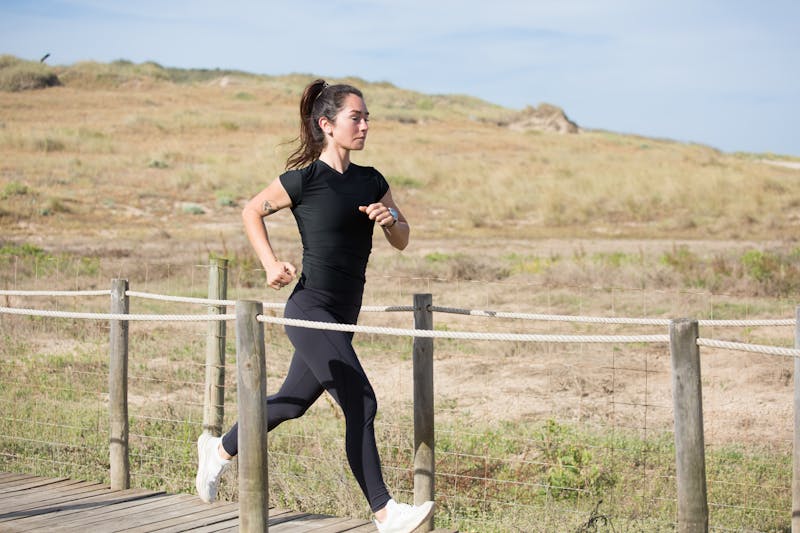يعد الجري طريقة رائعة للبقاء نشيطًا وصحيًا, ولكن بعض المضايقات تأتي مع المنطقة. إحدى هذه المشكلات هي احتكاك الحلمة, وتسمى أيضًا "حلمة العداء". هذه المشكلة الشائعة, نتيجة الاحتكاك بين الملابس والجلد, يمكن أن تجعل حتى أقصر مسافة لا تطاق.
لحسن الحظ, بالأدوات والنصائح الصحيحة, يمكنك منع الاحتكاك بالحلمة والاستمتاع بالتدريبات الخاصة بك دون قلق. سوف يستكشف هذا الدليل أسباب احتكاك الحلمة, كيفية التعرف عليه, والطرق الفعالة للوقاية منه وعلاجه.
افهمي احتكاك الحلمة

يحدث احتكاك الحلمة عندما تحتك ملابسك بشكل متكرر بالجلد الحساس للحلمتين. هذا الاحتكاك المستمر يمكن أن يسبب الاحمرار, تهيج, و, في الحالات الشديدة, نزيف.
لماذا يحدث ذلك؟?
غالبًا ما تتفاقم المشكلة بسبب الرطوبة الناتجة عن العرق أو المطر, مما ينعم البشرة ويجعلها أكثر عرضة للخطر. في ظروف أكثر برودة, الحلمات المنتصبة أكثر عرضة للاحتكاك, بينما الساخنة, الطقس الرطب يمكن أن يزيد من التعرق, تضخيم المشكلة.
لماذا تعتبر الوقاية مهمة؟?
يمكن أن يؤدي تجاهل احتكاك الحلمة إلى إزعاج كبير وحتى التهابات إذا تعرض الجلد للكسر. لا تؤدي الوقاية إلى تجنب هذه المشكلات فحسب، بل تساعدك أيضًا على التركيز على أدائك دون تشتيت انتباهك.
أسباب تهيج حلمة الثدي

الاحتكاك من الملابس
الملابس غير الملائمة أو الفضفاضة تتحرك على جلدك, خلق فرك متكرر يسبب الغضب.
تراكم الرطوبة والعرق
العرق يخلق العاصفة المثالية لغضب الحلمة. ينعم البشرة, يزيد الاحتكاك, ويترك وراءه ملحًا يمكن أن يتبلور, مما يجعل الأمور أسوأ.
العوامل البيئية
الظروف الجوية مثل المطر, حرارة, والبرد يمكن أن يساهم جميعها في احتكاك الحلمة. المتسابقون في سباقات الماراثون أو سباقات المسافات الطويلة معرضون للخطر بشكل خاص بسبب التعرض لفترات طويلة.
أعراض تهيج الحلمة

يسبب احتكاك الحلمة في البداية إحساسًا بالحرقان واللسع, والتي يمكن أن تتفاقم مع مرور الوقت, مما يؤدي إلى الألم, تهيج, وحتى النزيف, مما يجعل النشاط البدني غير مريح للغاية. تشمل العلامات النموذجية لتهيج الحلمة ما يلي::
- احمرار
- منزعج, مشقوق, تقشر الجلد
- حرق أو لاذع
- ألم يتراوح من الحنان الطفيف إلى الشديد
- نزيف
- القروح المفتوحة أو الجلبة
8 طرق لمنع احتكاك الحلمة أثناء الجري

حراس الحلمة للرجال
حراس الحلمة للرجال, على وجه التحديد أغطية الحلمة الشفافة, تم تصميمها لمنع احتكاك الحلمة وتهيجها أثناء الأنشطة البدنية مثل الجري, ركوب الدراجات, والتدريبات المكثفة. تحتوي كل حزمة 20 أزواج, مصنوع من مادة لاصقة طبية وسيليكون شفاف عالي الجودة لضمان الأمان, مريح, وملاءمة مقاومة للعرق.
أغطية الحلمة هذه سرية, غير مزعجة, خالية من اللاتكس, وخالية من مادة BPA, تقديم إزالة غير مؤلمة مع عدم وجود بقايا. إنها مثالية للارتداء طويل الأمد أثناء الماراثون, السباقات, جلسات رياضية, أو الرياضة مثل كرة القدم وكرة القدم. للاستخدام, ببساطة ضعيه للتنظيف, الجلد الجاف, وإزالتها بسهولة عند الانتهاء.
فيما يلي ثماني طرق عملية للحفاظ على نشاطك خاليًا من الفوضى.
1. استخدم مادة تشحيم جيدة
إن مادة التشحيم الجيدة هي خط دفاعك الأول. تطبيق المنتجات مثل الفازلين, بلسم مضاد للغضب, أو الكريمات المتخصصة تقلل الاحتكاك وتحمي بشرتك. قبل كل شوط, ضعي طبقة سخية على الحلمتين للحفاظ على سلامتهما.
2. ارتدِ الملابس المناسبة
تلعب الملابس التي ترتديها دورًا كبيرًا في منع الغضب. اختاري الأقمشة التي تمتص الرطوبة وتحافظ على جفاف بشرتك. تجنب القطن, لأنه يمتص العرق ويبقى رطباً, زيادة خطر التهيج. تعتبر القمصان الضيقة أو القمصان الضاغطة خيارات رائعة للعدائين’ حماية الحلمة لأنها تقلل من حركتها.
3. جربي بودرة التلك على حلماتك
بودرة التلك هي وسيلة سهلة لامتصاص العرق والحفاظ على جفاف بشرتك. ضع غبارًا خفيفًا قبل الجري لتقليل الرطوبة والاحتكاك. في حين أنها ليست فعالة على المدى الطويل, إنه حل بسيط للتدريبات الأقصر.
4. يستخدم شريط الحلمة للجري
تعتبر لصقات الحلمة أو الأشرطة اللاصقة فعالة للغاية في منع الغضب. تلتصق هذه المنتجات مباشرة بالحلمات, إنشاء حاجز مادي بين بشرتك وملابسك. إنها مفيدة بشكل خاص لسباقات الماراثون وغيرها من أحداث المسافات الطويلة.
5. يرتدي حمالات صدر رياضية سلسة
للنساء, حمالة صدر رياضية مناسبة يمكن أن يحدث كل الفرق. ابحث عن سلس, تصميمات ماصة للرطوبة توفر دعمًا ممتازًا دون تهيج الجلد. تجنبي حمالات الصدر ذات الخياطة الخشنة أو المقاسات الرديئة, لأنها يمكن أن تزيد الاحتكاك.
6. استخدمي أغطية الحلمة
أغطية الحلمة للرياضة, مثل حراس السيليكون, هي خيار رائع آخر. توفر هذه الأغطية القابلة لإعادة الاستخدام درعًا موثوقًا ضد الاحتكاك وتبقى في مكانها حتى أثناء الجري لمسافات طويلة. إنها مثالية للتعامل مع سباقات الماراثون أو جلسات التدريب في الظروف القاسية.
7. اختاري قمصان الجري لمنع احتكاك الحلمة
تم تصميم قمصان الجري عالية الجودة ذات الدرزات المسطحة والمواد الناعمة لتقليل التهيج. تعتبر قمم الضغط أيضًا خيارًا ممتازًا, لأنها تتناسب بشكل مريح مع جسمك, تقليل الحركة والاحتكاك.
8. ضعي الكريم بانتظام
بالإضافة إلى مواد التشحيم, يمكنك استخدام الكريمات المرطبة لتقوية بشرتك مع مرور الوقت. تعمل هذه الكريمات على تحسين مرونة بشرتك, مما يجعلها أقل عرضة للغضب. تطبيق منتظم, حتى في أيام الراحة, يمكن أن تساعدك على الاستعداد للتشغيل في المستقبل.
كيفية علاج الحلمات المتهيجة

إذا بدأت تشعرين بألم في منطقة الحلمة أثناء ممارسة الجري أو المشي, لم يفت الأوان بعد لتطبيق بعض مواد التشحيم. القيام بذلك يمكن أن يساعد في منع المزيد من التهيج.
يحتفظ بعض العدائين بأنبوب صغير من أكوافور أو فازلين في حزام الجري أو الجيب لمعالجة الاحتكاك. إذا كنت جديدًا في الجري أو التعامل مع مسافات أطول, إنها فكرة جيدة أن يكون لديك شيء في متناول اليد. ويجب على المشاة أيضًا اتخاذ التدابير الوقائية. للمشاركين في الماراثون أو السباقات الأخرى, غالبًا ما يتوفر في محطات المساعدة الطبية على طول الطريق الفازلين.
بعد تشغيلك
بعد الجري، يمكن أن يزداد ألم الحلمة أحيانًا بعد الانتهاء من الجري, خاصة عندما يصل الماء الساخن من الحمام إلى المنطقة المصابة. نظفي الحلمات الملتهبة بلطف باستخدام الماء والصابون المعتدل, ثم جففها جيدًا. مرة واحدة نظيفة, تطبيق أ&د- مرهم أو الفازلين, وقم بتغطية المنطقة بشاش يسمح بمرور الهواء لجعل ارتداء القميص أكثر راحة.
قد تحتاجين إلى الراحة لمدة يوم أو يومين حتى تشفى حلماتك من الاحتكاك. يمكن أن يسبب الاحتكاك المستمر ألمًا إضافيًا وقد يؤدي حتى إلى الإصابة بالعدوى.
إذا لم يتحسن الغضب في الحلمة
إذا استمر احتكاك الحلمة إذا كانت حلماتك مؤلمة, منتفخة, نزيف, متقشر, أو عدم الشفاء بالرعاية المنزلية الأساسية, من المهم أن ترى مقدم الرعاية الصحية الخاص بك. قد تحتاج إلى مرهم طبي أو, إذا أصيب, مرهم مضاد حيوي قوي بوصفة طبية.
خاتمة
قد يبدو احتكاك الحلمة بمثابة إزعاج بسيط, ولكنها يمكن أن تصبح بسرعة قضية مؤلمة ومدمرة إذا تركت دون معالجة. وذلك باتخاذ الخطوات اللازمة لمنع ذلك, مثل استخدام حماية حلمة العدائين, ارتداء الملابس المناسبة, وتطبيق مواد التشحيم, يمكنك أن تبقي جولاتك مريحة وخالية من القلق.
سواء كنت تستعد لماراثون الحلمة أو مجرد الاستمتاع بالركض السريع, الوقاية هي المفتاح للبقاء مركزًا وخاليًا من الألم. لا تدع الغضب يعيقك – استعد, اتبع هذه النصائح, وتشغيل بثقة!
الأسئلة الشائعة
ما الذي يسبب تهيج الحلمة أثناء الجري؟?
يحدث احتكاك الحلمة في المقام الأول بسبب الاحتكاك بين الحلمتين والملابس. الرطوبة من العرق, جنبا إلى جنب مع الأقمشة الخام, يضخم المشكلة.
كيف يمكنني منع الغضب الحلمة?
يمكنك منع احتكاك الحلمة باستخدام مواد التشحيم, ارتداء ملابس ماصة للرطوبة, واستخدام اللصقات الحلمة أو يغطي الحلمة للرياضة.
هل هناك أقمشة معينة أفضل لمنع الاحتكاك؟?
نعم, الأقمشة الاصطناعية مثل البوليستر أو النايلون أفضل بكثير من القطن. إنها تمتص الرطوبة وتقلل الاحتكاك, الحفاظ على بشرتك جافة ومرتاحة.
هل يمكن للمرأة تجربة احتكاك الحلمة أثناء الجري؟?
قطعاً. النساء عرضة أيضًا لغضب الحلمة, خاصة إذا كانوا لا يرتدون ملابس مناسبة, حمالة صدر رياضية بدون خياطة.
ماذا علي أن أفعل إذا أصبت باحتكاك الحلمة؟?
تنظيف المنطقة بلطف, تطبيق مرهم مضاد حيوي, وتجنب المزيد من الاحتكاك حتى تشفى بشرتك. استخدمي واقيات الحلمة أو لصقات الحلمة أثناء التعافي إذا كنت بحاجة إلى الجري.
هل هناك منتجات محددة موصى بها للوقاية؟?
نعم, منتجات مثل أغطية الحلمات المصنوعة من السيليكون للرياضة, بلسم مضاد للغضب, وقمصان الجري عالية الجودة فعالة للغاية.
لماذا بلدي الحلمات تؤذي بعد تشغيل الذكور?
ألم في الحلمة بعد الجري, المعروف باسم “حلمة العداء,” يحدث بسبب الغضب, والذي يحدث نتيجة الاحتكاك المتكرر بين الجلد والملابس. وهذا أمر شائع في عدائي المسافات الطويلة الذكور, وخاصة أولئك الذين يرتدون قمصانًا من الألياف الصلبة (مثل القطن) أثناء الجري لفترات طويلة في المناخات الباردة. العرق يزيد من حساسية الجلد, مما يؤدي إلى تهيج. تشمل الأعراض الألم, مثير للحكة, تورم, تشقق الجلد, والنزيف. لمنع هذا, ارتداء ملابس مناسبة مصنوعة من الناعمة, أقمشة ماصة للرطوبة, أو استخدمي مواد التشحيم مثل الفازلين والحواجز اللاصقة على الحلمات.
كيفية علاج الغضب بين عشية وضحاها?
لشفاء الغضب بين عشية وضحاها, اتبع هذه الخطوات:
- تنظيف المنطقة المصابة بالصابون المعتدل والماء.
- جفف المنطقة بلطف بمنشفة ناعمة.
- ضع مرهمًا مهدئًا مثل الفازلين أو الأكوافور لحماية وشفاء الجلد.
- ارتداء فضفاضة, ملابس ناعمة لتجنب المزيد من الاحتكاك.
- قم بإراحة المنطقة لمنع التهيج.
- حافظ على رطوبة جسمك وتناول الأطعمة التي تعمل على إصلاح البشرة والغنية بفيتامين E وC.
هذه الخطوات يمكن أن تساعد في تقليل التهيج وتعزيز الشفاء بين عشية وضحاها.